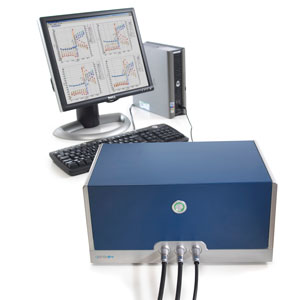
Quartz Crystal Microbalance with Dissipation monitoring (QCM-D) permits on one hand in-situ screening of very small mass changes and on the other hand yields information on changes in structure, viscosity or stiffness of a material.
QCM-D measurements benefit from the relation between eigenfrequency and mass of a quartz crystal. By using alternating voltage the quartz crystal is excited into resonance. If the mass of the crystal changes due to adsorption of mass (molecules, polymers, proteins, cells, etc.) the resonance frequency changes, Thus very small changes in mass can be detected and analysed, even on nano-scale. At SuSoS we use a method that does not only follow the change of mass, but also monitors the dissipation. By this we also yield information on the stiffness, viscosity or elastic modulus of a material. Hence we learn something about conformation, swelling behaviour and structure of polymers as well as how molecules are oriented on a surface.
Benefits of the analyzing technology
- In-situ and real time tracking of adsorption and desorption processes and structural changes
- flexible and versatile choice of sensor surface possible
- Investigation of numerous processes and interactions with different solvents and materials
Materials and Dimensions
- polymers, tenside/wetting agents, proteins and cells, nano particles
- substrate: SiO2, metals, ceramics, polymers
Contact us – and fathom new aspects of the properties of your product!

